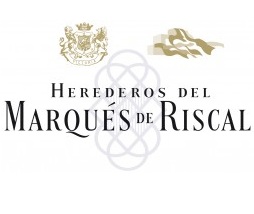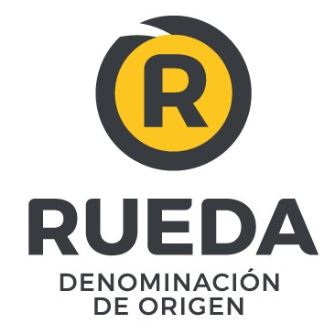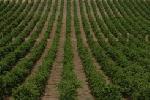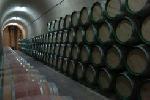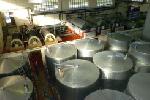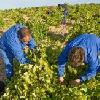Vinos de los Herederos de Marqués de Riscal - Bodega Rueda
In the early 70s, the wines of Marqués de Riscal Heirs decides to expand its product range with a white wine. After two years of trials, the Rueda region is the region chosen to produce it.
True to its pioneering spirit, Marqués de Riscal make a new young white wine, fresh and fruity in a region famous for its amontillado and oloroso. Other wineries followed, creating the Rueda in 1980.
Wines of the Heirs of Marqués de Riscal has the largest vineyard property Rueda (205 hectares), being also one of the first producers of local wines and one of the largest of Castilla y Leon.
Data Winery
Web of winery:
www.marquesderiscal.com
Address of the winery:
Ctra. N - VI Km 172,6 (Rueda - 47490 - Valladolid - Castilla y León - España)
Phone winery:
(34) 983868029 |
Mobile winery:
No Data
Fax cellar:
(34) 983868563
Person in charge of the winery:
D. Pedro Aznar Escudero
Winemaker:
D. Francisco Javier Hurtado de Amézaga
Barrels:
No Data
Acres:
455 Acres
Production Capacity:
No Data
National Distribution:
30%
International Distribution:
70%
Wine tourism and Shop On-Line






Brands
MARQUÉS DE RISCAL LIMOUSIN, FINCA MONTICO, MARQUÉS DE RISCAL SAUVIGNON BLANC, MARQUÉS DE RISCAL RUEDA VERDEJO.
Associated Wineries
Associated news
No news for this winery. To create news you can register as a user of LaEsenciaDelVino
Wines
Marqués de Riscal Limousin
Designation of Origin RUEDA
Wine made from Verdejo carefully selected from old vines pruned in glass, located in the best land gravelly higher terraces of the Douro River. This highly adaptable grape and good acidity, allows optimum fermentation and aging on lees in French oak barrels. The harvest is done manually in boxes of 15 kg capacity for subsequent pressing of the whole grapes without de-stemming. In this way is limited to the maximum oxidation and must retain all flavorings, color and freshness typical of this variety. After some clarification of the must, fermentation takes place in French oak barrels Allier, followed by aging on the lees which can last from 6-7 months.
View wineFinca Montico
Designation of Origin RUEDA
This wine comes from a vineyard our having more than 20 years and produced only about 5,000 kg per hectare is higher terraces of the Douro River, in typical gravelly soil, poor pebble which has traditionally high-quality wines from Rueda Verdejo. Harvesting is done by hand in boxes of 25 kg capacity, when the grapes reach the winery is cooled and lightly pressed without crushing and de-stemming (pressing of the whole grape), all cold to prevent oxidation and aromatic lost. It gets a little flower must yield but high quality. After the must is decanted desfanga or slightly and sent to the fermentation tanks. The fermentation is done with indigenous yeast for wine has greater aromatic character and originality. When the fermentation is finished the wine is left in contact with its lees for about four months. The lees are suspended moving them with nitrogen in the tank once a week (the lees are all already dead yeast population that precipitates at the bottom of the tank) This is done to increase the body, smoothness, complexity and stability aromatic wine. This period of contact with the lees have makes the wine more aromatic and color stability throughout the time that remains in the bottle. These wines are white but not barrel-fermented fresh and young endure much longer than usual white wines. The reason for this is that the dead yeast and, by autolysis, dissolved in the wine a number of substances from their cell walls, which react with the compounds responsible for flavor and color, thus increasing its stability over time.
View wineMarqués de Riscal Sauvignon Blanc
Designation of Origin RUEDA
The French variety Sauvignon Blanc, with which develops Riscal this varietal has its origin in the Loire region. It was introduced by Marques de Riscal Rueda in 1974 and today the winery has 70 hectares of vineyards. Now part of the varieties authorized by Rueda thanks to its adaptability to the environment and the ability to produce white wines of great aromatic intensity, good acid balance and minerality. The Marqués de Riscal Sauvignon follows the same process that the Verdejo Rueda. After a cold soak period and after extraction and clarification of wine, the slow fermentation is carried out at a controlled temperature of between 13 º C and 15 º C, to protect the primary aromas peculiar of this variety. After fermentation, the wine remains in contact with its lees, with the intention of increasing mouthfeel sensation and enhance their capacity for aging.
View wineMarqués de Riscal Rueda Verdejo
Designation of Origin RUEDA
Bodegas de los Herederos del Marqués de Riscal SL has 225 hectares of vineyards dedicated, among others, to the planting of native Verdejo variety. Versatile grape of great character and personality, is well adapted to the extreme conditions of the area, allowing the fresh white wines or fermented in barrel. The Verdejo Viura together with the also cultivated in Rueda, destemmed and once cooled, cold macerated in order to extract the maximum peel and aroma of the wine increased greasiness. The juice, clarified and clean once, performs slowly during 20 days fermentation at a controlled temperature of between 13 ° C and 15 ° C, in order to preserve the fruity character of this variety. After a period of maturation, the wine will be bottled in the months of January and March following the harvest.
View wine






